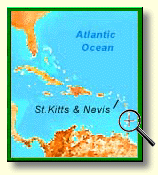| Location:
St. Kitts & Nevis are located in the northern part of the
Leeward Islands in the eastern Caribbean, 19 degrees north of the
equator, separated by a channel two miles wide.

Size:
St. Kitts is 23 miles long and 5 miles across
at its widest, encompassing an area of 68 square miles. The
island's
point of highest elevation is Mt. Liamuiga, at 3,792 feet. Nevis,
the smaller island, lies to the south and is approximately 7 miles
in diameter, covering a total of 36 square miles.
Climate:
Yearly average temperature is 79 degrees; annual
rainfall averages 55 inches; humidity is low, and constant
northeast trade winds keep the islands cool.

|

St. Kitts and Nevis, like no other islands in the Caribbean, seem
to embody a kind of lush tropical paradise usually associated with
the South Pacific. The atmosphere here is palpably luxuriant, an
intoxicating blend of sunlight, sea air and fantastically abundant
vegetation. At the center of St. Kitts stands the spectacular,
cloud-fringed peak of Mount Liamuiga (pronounced Lee-a-mweega),
a dormant volcano covered by dense tropical forest.
And on Nevis, too, the ground rises upward into a cloud forest
filled with elusive green vervet monkeys and brilliant
tropical flowers. For ecotourists, or simply anyone who enjoys
stunning natural beauty, St. Kitts and Nevis cannot fail to exceed
expectations. forest.
And on Nevis, too, the ground rises upward into a cloud forest
filled with elusive green vervet monkeys and brilliant
tropical flowers. For ecotourists, or simply anyone who enjoys
stunning natural beauty, St. Kitts and Nevis cannot fail to exceed
expectations.
And yet nature is only a small part of
the wonder of these small, relatively undiscovered destinations.
Long ago, St. Kitts
and Nevis were the pearls of the British Caribbean, rich and
enormously important islands that were celebrated throughout
Europe. Nevis, the "Queen of the Caribbees," possessed
unimaginable wealth from its super-productive sugar industry,
while on St. Kitts the impregnable fortress of Brimstone Hill
stood as the Gibraltar of the West Indies. In this venerable
history is plenty of romance as well, for it was on Nevis that the
dashing young Horatio Nelson met, courted, and wedded Fanny Nisbet,
all the while attending to the whirling social life of the
island's prosperous plantation estates.

Today these islands are esteemed more for their long stretches
of sugary sand than for their sugar
cane. Basseterre and Charlestown,
the islands' capitals, are among the most captivating and
picturesque of the Caribbean's colonial harbour towns. The law
here holds that no building here may be taller than the
surrounding palm trees, and on both St. Kitts and Nevis natural
preservation is a major value. Activities
include outstanding hiking through the
islands' rain forests, golfing on internationally ranked golf
courses, fishing, boating
and diving or snorkeling through
underwater reefs and unexplored wrecks. There is also an
exceptional wealth of historic points of
interest, including restored fortresses,
haunted plantations, and ancient petroglyphs. In the midst of all
of these attractions are many of the finest and most welcoming plantation
inns in the Caribbean. Still largely undiscovered, despite
their extraordinary beauty, their remarkable history, and their
unmatched charm, St. Kitts & Nevis offer a rare opportunity to
visit the "Secret Caribbean."
|
|



